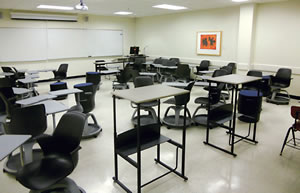Moving Education into the 21st Century
- By John Kilbourne
- 06/01/14
We have not evolved to sit in confining seats and desks, organized in neat tidy rows.
Promoting happy and productive places for discovery and learning should be at the core of the mission of education professionals. These teaching and learning areas include such moving innovations as exercise stability balls as chairs, fixed-height stand-up desks, node chairs, and buoy chairs. As a university professor, I have made it my mission to create an activity permissible classroom at Grand Valley State University in Allendale, Mich. To bring the classroom to fruition, I solicited grant funding to purchase exercise stability balls and fixed-height stand-up desks, reached-out to a local furniture company for innovative chairs and desks, and provided instruction for use with students, faculty and staff. My efforts and research has been recognized in hundreds of newspaper, television and radio commentaries throughout the United States (Google John Kilbourne and Exercise Balls or Yoga Balls).
For more than 20 years, I have been teaching college and university lecture/discussion courses in the typical classroom setting. The classrooms have usually consisted of 30 to 40 chairs with fixed attached desks organized in neat rows, all facing front. There was little opportunity to alter the configuration because of the confined space, time and the other classes that preceded and followed mine. In the fall of 2008, this all changed when I began to restructure my teaching space to be a more activity permissible classroom. I replaced the stern and imprisoning structure of the fixed desks with exercise stability balls as chairs at tabletop desks. Researching the effectiveness of the activity permissible space revealed that 98 percent of the students surveyed would like this option in every class. Responses to each question, from student’s ability to pay attention, take notes, engage in classroom discussions, and take exams were all positive. (For additional information and research on using exercise stability balls in classrooms please look to WittFitt: Learning in Motion, an organization dedicated to promoting active teaching and learning, www.wittfitt.com.)

PHOTO © ERMOLAEV ALEXANDER
During the spring of 2010, I expanded the options in the classroom to include fixed-height, stand-up desks as an additional choice for the students. In these courses students had the option of sitting on the exercise balls, standing at a desk or sitting in a regular chair at a table top desk. Some students used the balls, some used the standing desks and some used traditional chairs at desks, while still others sat in a regular chair with their legs or feet resting on a ball. It was the most exciting teaching and learning space I had ever experienced.
There are an increasing number of teachers using stand-up desks in classrooms. Many, including sixth grade teacher Abby Brown in Minnesota, who is a leader in the stand-up desk movement, are seeing many positive results from creating what Dr. James Levine from the Mayo Clinic calls “Activity Permissible” classrooms. Brown says she, “…got the idea for the stand-up desks after 20 years of teaching, during which she watched children struggle to contain themselves at small hard desks,” and after reading some of Dr. Levine’s work. She goes on to say, “it gives students choices, and they feel empowered. It’s not anything to force on anybody. Teachers have to do what fits their comfort level. But this makes sense to me.”
Children in Pam Seekel’s fifth-grade class in Wisconsin, are also experimenting with stand-up desks. She said, “At a stand-up desk, I’ve never seen students with their heads down, ever. It helps with being awake, if they can stand, it seems. And for me as a teacher, I can stand at their level to help them. I’m not bent over. I can’t think of one reason why a classroom teacher wouldn’t want these.”
Several recent studies on the benefits of standing while at work or in school were neatly organized in Olivia Judson’s article, “Stand Up While You Read This.” Judson, who writes on the influence of science on modern life for the New York Times said, “It doesn’t matter if you go running every morning, or you’re a regular at the gym. If you spend most of the rest of the day sitting — in your car, your office chair, on your sofa at home — you are putting yourself at increased risk of obesity, diabetes, heart disease, a variety of cancers and an early death. In other words, irrespective of whether you exercise vigorously, sitting for long periods is bad for you.”

PHOTO COURTESY OF JOHN KILBOURNE
Standing at a desk instead of sitting may help a person burn as many as 50 more calories per hour. Over the course of a four- to six-hour day, that additional 50 calories per hour may add-up to 200-300 extra calories burned per day. Those extra calories burned can help with weight loss over time.
The far-reaching publicity the new classroom at GVSU received led me to the furniture maker Steelcase who offered to add their new Node desk/chair to the classroom. Grand Valley State University was one of three schools selected to pilot the new desk/chair.
I predict the next major revolution in teaching and learning will come from altering the environment and making classrooms more activity permissible. As Environmental Studies Professor David W. Orr, of Oberlin College, recently shared, “The chair in short originated in the industrial ordering of education. It is maintained by profit-seeking school suppliers and unimaginative administrators who see no other possible arrangement of the body, or bodies, or any possible downside to the lower back from six hours of enforced seating.”
At present, we are experiencing a wave of new imaginative classroom design. Teachers and students who I know that have experienced an activity permissible classroom are not turning back. This is plainly obvious from the activity in my classroom at GVSU. When I arrive in the morning, the custodial person has all of the Nodes lined-up in neat rows. By the end of this first class period, the chairs are scattered in orderly disorder. Moreover, the conversation between students prior to the class starting has been greatly enhanced as students are free to swivel and talk to their neighbors. We have not evolved to sit in confining seats and desks, organized in neat tidy rows.
As I write, I am again working with Steelcase to pilot their new buoy chair into the aforementioned classroom, which has many of the qualities of an exercise stability ball but is much sturdier and will adjust to the height of each student.
The influence that permissible activity has on teaching and learning has been well documented throughout history. From Plato’s and Aristotle’s School of Athens, to Rousseau’s Emile, to Dewey’s Experience and Education, to present day educators in Denmark who often use classroom seats that allow students to sit or stand, teachers and students have gravitated to educational spaces that allow for more freedom to move.
As education professionals, we can help make the classroom experiences more activity permissible, thus providing additional opportunities for the promotion of creative and productive students. Using our expertise to help our schools move towards more activity permissible classrooms is one path to this future.
This article originally appeared in the issue of .